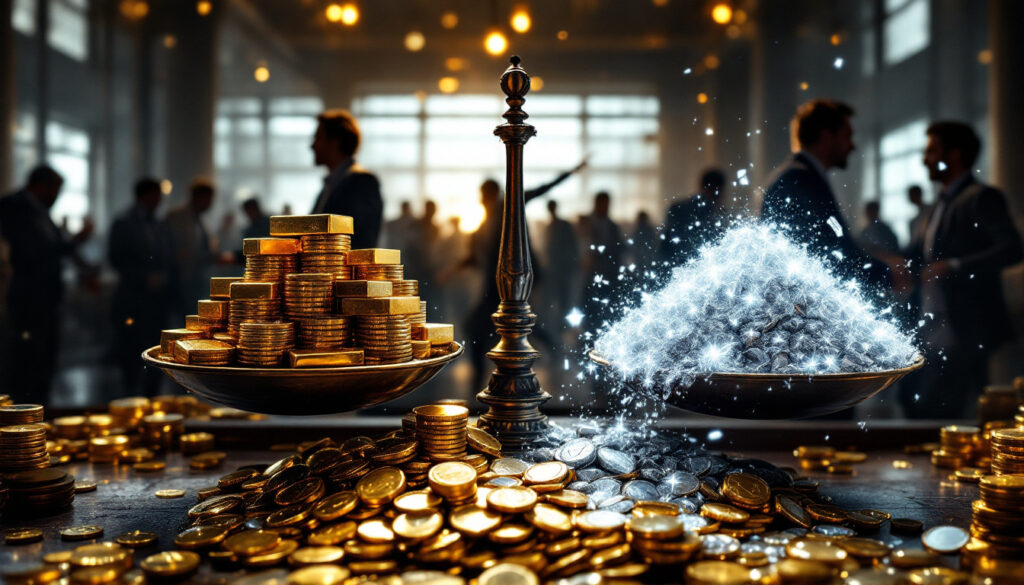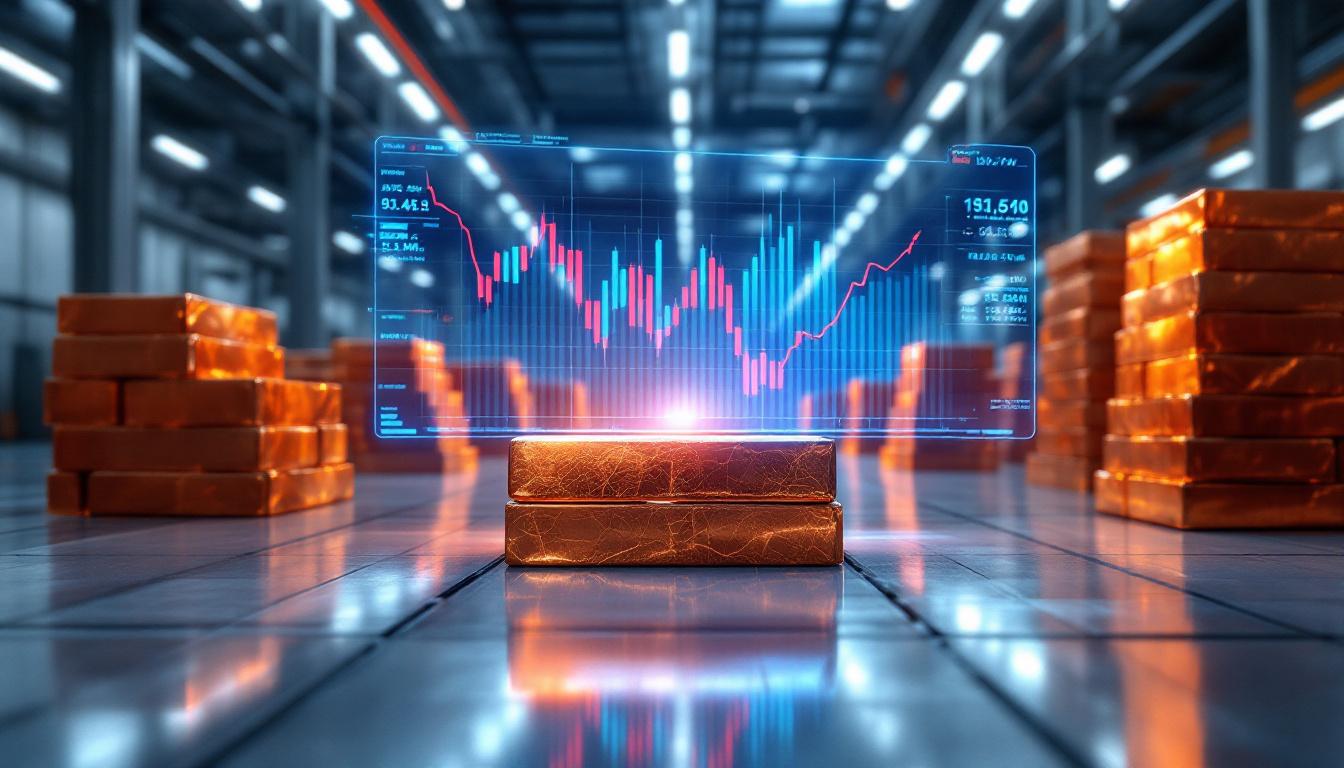What Is a Gold to Silver Swap?
A gold to silver swap is a strategic transaction where investors exchange their gold holdings for silver (or vice versa) based on the relative value between the two metals, typically measured by the Gold-to-Silver Ratio (GSR). This strategy allows investors to potentially increase their total precious metal holdings by capitalizing on price disparities between gold and silver.
How the Gold-to-Silver Ratio Works
The GSR measures how many ounces of silver it takes to purchase one ounce of gold. In April 2024, market volatility pushed this ratio to extreme levels, reaching 102:1. This means it took 102 ounces of silver to buy just one ounce of gold—a historically significant imbalance.
Throughout history, this ratio has fluctuated dramatically, ranging from below 20:1 in the 1970s to over 100:1 during recent market disruptions. Geologically, silver is approximately 17-20 times more abundant than gold in the Earth's crust, which many analysts consider a natural baseline for the ratio.
When the ratio exceeds 80:1, many experienced investors view this as a signal to convert gold holdings to silver, essentially "buying silver cheap" relative to gold. This strategy isn't about predicting absolute price movements but rather capitalizing on the relative value between the two metals.
Why Consider a Gold to Silver Swap in Today's Market?
Recent Silver Market Volatility
April 2024 saw remarkable volatility in the silver market, with prices plummeting 12% in just two days (April 2-4). Silver dropped precipitously from $34 per ounce to $29.59 before beginning to stabilize. This rapid decline created both panic and opportunity in the precious metals community.
The volatility wasn't driven by fundamental changes in silver's industrial demand or mining output, but rather by large-scale trading positions being liquidated in response to broader market movements. This disconnection between price action and physical market fundamentals is precisely what creates strategic openings for ratio traders.
Current Gold-to-Silver Ratio Analysis
During the April 2024 market turbulence, the GSR spiked to approximately 100:1—far above historical averages. To put this in perspective, the ratio has averaged closer to 60:1 over the past century, making the current environment potentially advantageous for investors looking to swap gold for silver.
Investment analysts who specialize in precious metals often describe these extreme ratio events as "rubber band" scenarios—the further the ratio stretches from historical norms, the stronger the eventual reversion might be. If the ratio were to normalize to even 70:1, investors who executed gold to silver swaps at 100:1 could significantly increase their total metal holdings when converting back.
How Do Gold to Silver Swaps Work at Coin Shops?
Typical Transaction Structure
When executing a precious metals swap at a dealer, the process differs significantly from standard buying or selling. Rather than a simple cash transaction, dealers calculate the wholesale value of both metals being exchanged, accounting for current spot prices and product premiums.
Most dealers apply a service fee ranging from 2-3% to cover their operational costs and risk exposure. This fee is typically lower than what you'd pay when selling metals for cash and then repurchasing different products.
The actual exchange ratios vary substantially depending on the types of products involved. Generic products like bars and rounds generally yield more favorable ratios compared to premium products like government-minted coins.
Real Transaction Example
In a recent transaction documented by a major U.S. coin dealer, a customer exchanged 15 one-ounce gold bars for Buffalo silver rounds. At current wholesale prices, this exchange would theoretically yield 1,507 ounces of silver based on the spot ratio.
After applying a 2% dealer fee, the customer received 1,500 ounces of silver plus paid a small cash difference. The total cost of the transaction amounted to approximately $600-700 beyond the metal exchange itself—significantly less than the combined spread of selling gold for cash and then purchasing silver separately, which would have cost the investor roughly $1,500 in transaction costs.
What Factors Affect Your Gold to Silver Swap Value?
Premium Differentials Between Products
Product selection dramatically impacts swap outcomes. In a documented exchange, swapping a one-ounce gold bar for American Silver Eagles yielded approximately 92-93 ounces due to the Eagles' high premium over spot price. The same gold bar exchanged for generic silver rounds would have yielded 96-97 ounces—a significant difference of 4-5 additional ounces.
These premium differences become increasingly consequential when executing larger swaps. For instance, exchanging 100 ounces of gold could result in a difference of 400-500 ounces of silver depending on product selection—a substantial amount representing thousands of dollars in value.
Premium structures also vary geographically and between dealers. Rural dealers often command higher premiums than urban counterparts due to lower competition and higher operational costs. Online dealers frequently offer the most competitive rates but may have longer delivery timelines.
Market Timing Considerations
Timing is perhaps the most critical factor in ratio trading. Historically, the gold-silver ratio has fluctuated between approximately 30:1 and 100:1, with occasional extreme outliers. Many experienced investors establish specific ratio thresholds that trigger their swap decisions.
The current ratio of approximately 100:1 represents a compelling opportunity when viewed in historical context. Silver has historically rebounded more dramatically than gold when recovering from market downturns, potentially amplifying returns for investors who positioned themselves appropriately during ratio extremes.
Interestingly, these ratio extremes tend to occur during periods of market stress or volatility. The COVID-19 pandemic saw the ratio briefly exceed 120:1, while the 2008 financial crisis pushed it above 80:1. These patterns suggest that major dislocations in financial markets can create advantageous entry points for ratio traders.
How Do Market Conditions Impact Precious Metal Swaps?
Supply Chain and Delivery Considerations
As of April 2024, the silver market is experiencing significant supply chain constraints, with typical delivery delays of approximately 4 weeks on many silver products. This situation resulted from a surge in demand following the price drop, quickly depleting available inventory across the distribution network.
These delays don't indicate a shortage of raw silver but rather manufacturing and distribution bottlenecks. Mints and fabricators have limited capacity to convert raw silver into retail products when demand spikes suddenly. This creates a situation where customers are effectively "buying their spot in line" for future delivery rather than receiving immediate fulfillment.
Geological factors also influence these market dynamics. Unlike gold, nearly 60% of silver production comes as a byproduct of mining other metals (primarily copper, lead, and zinc). This means silver production cannot quickly respond to price signals as miners are primarily focused on the economics of their primary target metals.
Premium Trends in Current Market
The recent market volatility triggered multiple premium increases across product categories. Generic silver rounds saw their wholesale costs rise from spot price to approximately $0.55 over spot in just three weeks as suppliers struggled to meet demand.
Retail premiums increased by around $0.25 per ounce on many products, with some dealers implementing tiered pricing based on purchase quantity. Even American Silver Eagles, which already commanded high premiums, saw modest increases despite their already elevated price structure.
This premium expansion creates a peculiar dynamic: even as the spot price of silver declined, the actual cost to acquire physical silver remained relatively stable due to rising premiums. This disconnect between paper and physical markets highlights the importance of focusing on the total acquisition cost rather than just the spot price when planning swap transactions.
What Strategies Do Expert Investors Use for Metal Swaps?
"Deep Stack" vs. "Light Stack" Approach
Sophisticated precious metals investors often segment their holdings into different categories with distinct purposes. The "deep stack" approach involves maintaining core holdings that remain largely untouched except during extreme market conditions or ratio opportunities.
These deep stack holdings typically consist of lower-premium products like bars and generic rounds that maximize metal content per dollar invested. In contrast, "light stack" holdings include more liquid assets that might be regularly traded or liquidated as needed.
Expert investors typically execute ratio trades using only their deep stack holdings, preserving core positions while capitalizing on mathematical advantages offered by extreme ratios. This disciplined approach helps avoid emotional decision-making during market volatility.
Target Ratio Thresholds
Experienced precious metals investors establish clear ratio thresholds that trigger their swap decisions. Many consider a GSR above 80:1 as a signal to begin converting gold to silver, with more aggressive conversions at 90:1 or higher.
For the reverse trade (silver back to gold), common thresholds include ratios below 50:1, with accelerated conversion at 40:1 or lower. Some investors use a more granular approach, converting specific percentages of their holdings at different ratio levels to average their entry points.
These predetermined thresholds serve an important psychological purpose: they remove emotional decision-making during periods of market volatility when fear and greed might otherwise cloud judgment. By establishing rules in advance, investors can execute their strategy mechanically when opportunities arise.
How Do Retail Investors Respond to Silver Price Volatility?
Observed Buying Patterns
Dealer observations reveal fascinating behavioral patterns during price volatility. The April 2024 silver price drop triggered a significant increase in retail customer activity, with many experienced investors "buying the dip" while some newer investors sold out of fear.
This bifurcated response highlights the psychological dimension of precious metals investing. Seasoned investors often view price drops as buying opportunities, while less experienced holders may panic and liquidate positions. This transfer of metal from "weak hands" to "strong hands" is a recurring pattern during market dislocations.
Transaction volumes typically increase dramatically during such periods. One major dealer reported processing three times their normal daily volume during the height of the April 2024 volatility, with a buying-to-selling ratio of approximately 5:1, indicating overwhelmingly more buyers than sellers despite the price decline.
New Investor Behavior
Price drops consistently attract first-time precious metals buyers. Many report having considered investing previously but were finally motivated to act by the combination of media coverage and lower entry points. This phenomenon of "buy the dip" mentality is particularly strong in silver markets due to the metal's relative affordability compared to gold.
Dealers report that media coverage significantly influences new investor behavior. Even when silver prices drop to levels that are higher than previous stable periods, the narrative of a "price crash" can drive new buying interest simply because the downward movement generates headlines.
Many new investors express concerns about economic stability, currency devaluation, or inflation as their primary motivations for entering the precious metals market. These macroeconomic concerns tend to intensify during periods of market volatility, driving increased participation from investors seeking perceived safe havens.
What Are the Practical Considerations for Gold to Silver Swaps?
Storage Requirements
The physical properties of silver create unique storage challenges when converting from gold. At a GSR of 100:1, exchanging just one ounce of gold results in 100 ounces of silver—an approximately 100-fold increase in storage volume and weight requirements.
This scaling issue becomes particularly significant with larger holdings. While $50,000 in gold can be comfortably stored in a small safe deposit box, the equivalent value in silver requires substantially more space. Home storage of significant silver holdings may necessitate reinforced flooring due to weight considerations, with 1,000 ounces weighing approximately 68 pounds.
Security considerations also evolve with increased volume. Gold's high value-to-weight ratio makes it easier to transport discreetly and secure effectively. Silver's lower density of value may require more robust security measures and complicate emergency relocation if necessary.
Liquidity Differences
Gold typically offers greater liquidity than silver, particularly for large positions. Selling $100,000 of gold can usually be accomplished in a single transaction with minimal market impact. The equivalent silver position might require multiple transactions or buyers, potentially impacting the realized price.
Transaction costs also differ significantly. The bid-ask spread for gold typically runs 1-3% for most products, while silver spreads can range from 3-8% depending on product type and market conditions. This spread difference becomes particularly relevant when executing both sides of a ratio trade (gold to silver, then eventually silver back to gold).
Transportation logistics represent another practical consideration. While $50,000 in gold can be hand-carried, the equivalent in silver requires vehicle transportation and potentially multiple trips. These logistical factors should be carefully considered when planning significant ratio trades.
FAQs About Gold to Silver Swaps
What is the ideal Gold-to-Silver ratio for making a swap?
The ideal ratio depends on your investment strategy, but many experts consider ratios above 80:1 favorable for swapping gold to silver, while ratios below 50:1 may signal opportunities to swap back to gold. Historical analysis shows the ratio has averaged approximately 60:1 over the past century, making extreme deviations from this average potential trading opportunities.
Does a high demand for silver mean there's a silver shortage?
No. Product delays don't indicate a silver shortage but rather manufacturing and distribution bottlenecks. Raw silver exists in adequate quantities, but converting it to retail products takes time during high-demand periods. The disconnect between paper and physical markets can create premium increases without reflecting true scarcity of the underlying metal.
How do dealer premiums affect swap transactions?
Dealer premiums can significantly impact your swap value. Higher premium products like American Silver Eagles will yield fewer ounces than lower premium products like generic rounds or bars when swapping from gold. For example, a one-ounce gold bar might yield 93 Silver Eagles versus 97 generic rounds—a difference that compounds with larger transactions.
Why do investors often wait for price drops before buying silver?
Many investors respond to media coverage rather than absolute price levels. A significant price drop generates news coverage that attracts attention, even if the resulting price is higher than previous stable periods. Additionally, the psychological satisfaction of "buying the dip" motivates action, even when previous opportunities at similar or lower prices were available but not publicized. Understanding gold price trends and gold and silver market dynamics can help investors make more informed decisions about the optimal timing for these swaps.
When considering a gold to silver swap, it's important to stay informed about current Gold ETFs 2024 strategies and comprehensive gold market analysis to maximize your investment outcomes. For those new to the precious metals space, a beginner's guide to mining stocks can provide additional context about the broader industry that produces these valuable metals.
Want to Be Alerted to the Next Mining Discovery Before Prices Surge?
Discovery Alert's proprietary Discovery IQ model instantly notifies you of significant ASX mineral discoveries, empowering you to make informed investment decisions before the broader market reacts. Explore how major discoveries have historically generated exceptional returns by visiting the Discovery Alert discoveries page and position yourself for potential gold-silver ratio trading opportunities.




